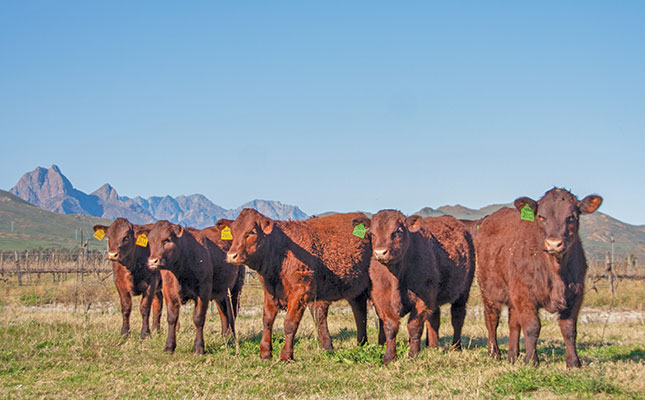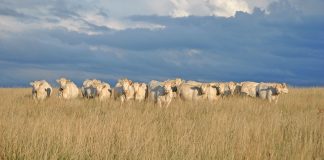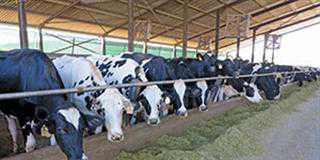
Photo: Nollie Stofberg JR
Last year, the Stofbergs, who own the Platfdrif Sussex Stud and farm near Rawsonville in the Boland, became some of the first Sussex cattle breeders in South Africa to use embryo flushing. Owner Nollie Stofberg says the family took this step in memory of his second-eldest son, David, who died in 2018 at the age of 24 following a car accident.
“Back in 1981, David’s maternal grandfather and namesake was one of the first Angus breeders in South Africa to use embryo flushing to accelerate genetic gains in his stud. As a family, we always wanted to try embryo flushing on [Platdrif], and David, with his master’s degree in animal production, was especially passionate about it,” says Nollie.
His eldest son, Pieter, explains that embryo flushing is a breeding technique that entails collecting embryos from donor cows and implanting them in surrogate cows, which then carry the embryos to term.
As with any type of breeding, donor and surrogate cows have to be in good condition to ensure a positive outcome.
How embryo flushing works
The donor cows are superovulated and artificially inseminated. A month later, the embryos are removed surgically and graded in a laboratory according to their quality. The embryos can be implanted into surrogate cows directly thereafter, or frozen for future use.
“Being able to freeze the embryos gives you access to the genetics of your top cows years after they’ve died,” says Pieter.
Surrogates receive hormone treatment to ensure successful implantation.
“The take percentage is 40% to 50% with embryo flushing, compared with about 70% with artificial insemination (AI). The percentage is somewhat higher if you use fresh embryos instead of frozen ones,” adds Pieter.
The Stofbergs employ In Vitro Africa to manage the process, as embryo flushing and transference entail technical procedures that should be done by a veterinarian.
Three of their top cows were flushed in April 2020; 10 embryos each were collected from two cows and four from the third cow. Two months after being flushed, the donors were placed with bulls to reproduce naturally, along with the rest of the cows of the stud, without any complications.
The embryos were implanted into Holstein cows belonging to a neighbouring dairy farmer at Oudewagendrif Boerdery.
“We decided to use the Holsteins, because embryo flushing has become quite a common procedure in the dairy industry and our neighbour has the facilities to accommodate it. It also enabled us to continue with our stud breeding programme as usual,” says Nollie.
Only six of the 17 surrogacies took, leading to the birth of three bulls and three heifers in February this year.
The calves were raised and received milk rations along with the dairy calves on the neighbour’s farm, and were taken to another of Nollie’s farms, Swartwalle, when they were three months old. They received creep feed from two months of age to stimulate their rumens.
“We were a little disappointed by the poor outcome [of the surrogacies] and are still discussing what to do differently next time. For one, we’ve learnt from dairy farmers that the take percentage is influenced by climatic conditions, so we’ll rather do it in September, when it starts getting warmer, instead of April, when it begins to get colder,” says Pieter.
They are also still deciding whether they should use their own cows or others as surrogates.
Benefits of flushing
Embryo flushing enables farmers to produce more offspring from their top cows. Pieter explains that cows can be flushed every two months to produce offspring, whereas only one to two offspring can be produced per year via AI or natural breeding techniques.
Flushing also presents new market opportunities. According to Pieter, embryos can be sold locally or exported, depending on South Africa’s foot-and-mouth disease (FMD) status.
“Embryos are not only cheaper than live animals, but represent significantly lower disease risks and eliminate the risk of animals being injured during transportation to a new destination.”
For now, the Stofbergs plan to use the embryos to improve their own live offering, after which they will consider selling the embryos locally.
Nollie points out that Sussex cattle have traditionally been underestimated, but demand has picked up over the past few years due to the growing awareness of the breed’s value in crossbreeding programmes, particularly with indigenous and synthetic breeds such Simbra, Brahman, Bonsmara, Afrikaner, Nguni and Boran.
“The Sussex is usually dominant in the offspring and presents optimal heterosis in synthetic and indigenous breeds, because it’s so unrelated to them,” he says.
Nollie began farming the breed in 1985 to add value to his land, which was unsuited to vineyard and citrus production. “I specifically chose Sussex cattle because of their ability to thrive on sourveld.”
He started with 10 Sussex-type cows and a bull, but ventured into stud breeding in 1994 when he realised it would be the best way to augment the land.
Today, Platdrif Sussex, despite its mere 75 cows, is considered one of the best studs in South Africa, and buyers come from all over the country, Namibia and Zimbabwe to acquire its top genetic material.
Over the past six months, prices for good genetic material at auctions have grown by 10% to 15%. The Stofbergs sold their six bulls for an average of R98 333 at the latest National Sussex Auction, up from last year’s price of R96 250 per bull. Five of the bulls were sold to other breeders, which is testament to the quality of the stud.
“It’s really great to see that our genetics are adding value on a national level,” says Nollie.
He ascribes the rise in prices to farmers rebuilding their cattle herds due to improved weather conditions in previously drought-stricken areas, good maize and soya bean harvests, the growing demand for meat, and many game breeders reverting to cattle farming due to the impact of the COVID-19-related measures placed on the industry.
Disease-free cattle
To give buyers even more value and guarantee disease-free genetic material, Platdrif Sussex last year registered on V-Plan, a platform developed by Veterinarian Network director Dr Danie Odendaal.
The system enables the health status and disease-prevention management practices of cattle herds to be recorded and continually updated.
Participating veterinary practices, of which there are approximately 160, report diseases on the platform in real time. The data is then used to provide the veterinarians with an overview of the disease risks and threats at district and national level.
The programme also flags various problem diseases, such as brucellosis, FMD and sexually transmitted diseases, which prevent participating farmers from selling their livestock if there are any outbreaks on their farms.
To participate in V-Plan, a breeder must work with a veterinarian who, in turn, needs to create an animal health programme for his/her stud. This is reviewed annually and the veterinarian also has to visit the farm at least twice a year to evaluate the health status of the herd and test the cattle for brucellosis and sexually transmitted diseases. These visits usually coincide with fertility checks.
The stud owners also have to observe their animals and report disease symptoms to the veterinarian as soon as these are spotted. Records of the health management programmes and test results are kept and included in production records for prospective buyers.
Plans for the future
In the past, the Stofbergs used AI to introduce polled genetics from Australia and the UK into their stud.
“I won’t say that embryo flushing is better than AI, as it really depends on what you want to achieve. However, it’s claimed that embryo flushing increases the impact of top cows on a stud by 10 times,” says Pieter.
The family also makes use of performance testing and estimated breeding values to help with the selection of animals, although the physical appearance of an animal still carries weight.
“We look for a good balance between the physical appearance and the breeding values. It doesn’t help to have an animal with exceptional breeding value if it’s deformed,” says Pieter.
The biggest disadvantage of embryo flushing is that it’s very expensive; Nollie estimates that it costs up to 15 times more than AI.
Nonetheless, he considers it money well spent. “You can definitely see the superiority of our calves produced via embryo flushing, with three of them being offspring from a bull that won the 2018 Bloemfontein Show.
“A stud breeder cannot afford to be complacent; embryo flushing is definitely one tool that can help a stud breeder stay ahead in the game.”
Email Nollie Stofberg at [email protected] or visit platdrifsussex.co.za.











